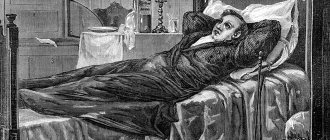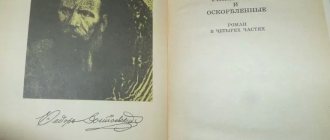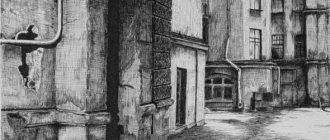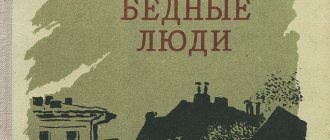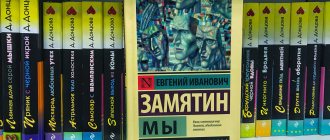What was Dostoevsky up to?
The novel did not come straight away and was not easy for the writer. And then it was ambiguously received by readers of his time. Fyodor Mikhailovich had the artistic talent of a fortuneteller. And he was one of the first to see, describe, and warn people about many things. But, alas, his warning was not noticed.
In August 1867, Fyodor Mikhailovich wrote to his friend Maikov that there was a novel, but black on white was still not enough. That is, there is a plan, but so far little has been written. It appeared when Dostoevsky was writing Crime and Punishment. But the novel we know came out only on the third try. Dostoevsky took an advance of 4.5 thousand rubles from the editor and hoped to complete the work by the end of 1867. However, this did not work out.
Dostoevsky, while abroad, tried to assess the state of Russian society. From the newspapers, he noticed that cases of strange murders had become more frequent. For example, the murder of a jeweler by a millionaire, the Ulitsky case. And for Fyodor Mikhailovich, the theme of murder in the novel “The Idiot” is not in last place. Dostoevsky comes to the terrible conclusion that Russian society is sick. And he has two questions: have the Russian people really preserved Orthodoxy? And are these people ready for the second coming of Christ? And here the problem arises: is it possible to depict Christ in art?
RUSTUTORS
PRINCE MYSHKIN
- hero of F. M. Dostoevsky’s novel “The Idiot” (1867-1869). In the novel “The Idiot,” Dostoevsky summed up many of his thoughts about Christianity, about the personality of Christ and the fate of his teachings in the world. “The main idea of the novel,” wrote Dostoevsky, “is to portray a positively beautiful person.” Listing the best examples of world literature that he was guided by, Dostoevsky says that the only “positively beautiful face” for him is Christ. And also Don Quixote, but he is beautiful because at the same time he is funny, which is why “compassion appears for the beautiful that is ridiculed and does not know its worth.”
The word “idiot,” according to V. Dahl, means “little-minded, thoughtless from birth, stupid, wretched, holy fool.” Dostoevsky endowed M. with that “lack of understanding from birth,” for which the prince was treated in Switzerland by Dr. Schneider. He arrived in Russia penniless, not knowing where he would live, but with great curiosity about the country where he was born. He is open to everyone he meets, like a child, and joyfully ready to accept everything that the world shows him. At the same time, M. is full of his serious thoughts and does not know to whom he can express them. The first person to whom he expresses his impressions of the death penalty and his conviction that it is impossible to kill for murder is a footman in the house of General Epanchin. M. takes this “man” for a person and thus completely confuses him. The prince guesses all the characters in the novel, seeing right through their insides, their plans, but without planning any of his own roles in their destinies, no self-interest. Everything appears as if by itself. M. sees people as disunited, disconnected - his role is to connect what is disconnected, to resurrect human souls, to turn people towards each other. Each time he is an apologist for someone else’s soul and its healer.
But it is impossible to cure these souls - the circumstances of real life are stronger than the prince, and, without wanting it, he only provokes disasters every time. His simplicity and kindness are only a reason for discord in a society where self-interest and possessiveness are the fundamental principles. His ability to sympathize is at first puzzling, arouses suspicion and disbelief in everyone, and then becomes a real misfortune for the prince, because in the confusion and chaos of various situations he comes to the idea that “compassion is the main law of existence,” and it is no longer possible to abandon this thought Maybe.
Prince M. believed in this truth, which no one believes in. Everyone suffers in their own way; however, no one sympathizes. Each yearns for participation and help, but does not know how to help the other.
Even in Switzerland, M. realized that he felt good only with children: “Through children the soul is healed...” But in the novel “The Idiot” there are no children, only thirteen-year-old Kolya Ivolgin (who, by the way, understands what is happening more than adults). Dostoevsky abandoned the idea of describing the “children’s club” that arises around the prince. “The prince is in action”, “steadfast in action” - this remained outside the scope of the novel. The prince has no “business”. His “business” becomes the life of Nastasya Filippovna, Aglaya, Ippolit. The gift of insight allows the prince to discern a child in each of these very different characters, and each such child becomes the prince’s tormentor, because he has long grown up and is captured by his passions and illnesses. “Oh, what a little child you are, Lizaveta Prokofievna!” - M. turns to General Epanchina, she agrees, and then completely torments the prince with her parental concerns. Of course, Aglaya is also a child, but this child is absurd, capricious, spoiled. Most of the novel is devoted to Hippolytus, a consumptive young man who wants to “explain” to humanity before dying, tries to shoot himself, writes “Explanation,” etc. M. and here he understands the very essence: Hippolytus is lonely, exhausted by his complexes and longs for simple human participation.
The biggest, irreparable misfortune for the prince is Nastasya Filippovna, whose face, first seen in the portrait, struck him with a combination of suffering and pride. Nastasya Filippovna's suffering becomes agony and horror for M. - he does not know how to treat it.
The action of the novel takes place on Gorokhovaya, on Peski, now in Pavlovsk, now on Petrogradskaya, it is excited by the atmosphere of a strange city. Petersburg acquires, as it were, its own power over people and, in particular, over M., but this is no longer the same power that the city had over the Dreamer in White Nights. That power is full of poetry and youthful charm. Now we see a different city, or rather the same one, but at a different time. It is no longer separated from the world, it is connected to Europe by railway. And what is called Western civilization is bizarrely reflected in the Russian mirror. In the outline for “The Idiot”, on every page there is a crime, money, sale, career, trial, etc. All this looks like a confused picture drawn by the hand of a madman. One terrible face appears, is immediately erased, covered by another face, a figure, only a hand, only an eye, but in this eye there is the same passion, the same horror. As the novel progressed, the plot became clearer, and an incredible female figure emerged at its center. He struck the prince. He, like a weak child, was drawn into the whirlwind of human relationships, in the center of which was Nastasya Filippovna. He saw her, and now, no matter what he thinks, he lives only for Nastasya Filippovna. They, without coming together, have already come together - they have a common loneliness and height of spirituality. Dostoevsky writes in his notebook: “Christian love is the Prince.” And he marks three times in the margins of his drafts: “Prince Christ.” M. is endowed with the gift of “higher love”, devoid of prudence. But this “highest love” of the prince, who is innocent and does not know women, turns into torment for Nastasya Filippovna. The woman knew (even as a girl she learned) the offensive passion of the depraved Totsky, then she recognized the passion of Rogozhin, who was thinking of buying her for a hundred thousand. In the prince she “saw a person” for the first time. She saw it and fell in love, although she hides it for the time being. But the prince does not hide anything, “he would only love.” For him, kissing the portrait of Nastasya Filippovna is an absolute, complete expression of a feeling that does not expect greater completeness. From the point of view of ordinary people, this is idealism, free chivalry. The latter was noted by Aglaya, directly addressing M.’s poems about the “poor knight.”
“Something heavy and unpleasant seemed to sting the prince” when he heard this reading. His “highest love” became a subject of admiration, but at the same time ridicule. Aglaya invaded where no one belongs, and violated what cannot be violated. Aglaya's invasion into the prince's intimate life becomes fatal: M. becomes confused and in the end no longer knows, cannot say who he loves, Aglaya or Nastasya Filippovna. He comes to love both; Against his will, the prince pits two women against each other in a brutal duel.
And then Prince M. becomes completely confused - he consoles Nastasya Filippovna, obediently becomes her fiancé, outwardly calmly accepts the news that she ran away with Rogozhin, searches throughout the city for Nastasya Filippovna and Rogozhin, in fact, already knowing what happened. The prince’s mind could not withstand everything that he had to see and experience in Russia - “the prince ended up abroad again, in Schneider’s Swiss establishment.”
The greatest theater masters performed on the Russian stage in stagings of The Idiot. In 1899, N.I. Vasiliev played at the Maly Theater, and R.B. Apollonsky at the Alexandria Theater. The famous performer of this role was N.N. Khodotov. In 1957, thanks to I.M. Smoktunovsky, the BDT performance (staged by G.A. Tovstonogov) became a big event. In 1958, in a play staged by A.I. Remizova at the Theater. Vakhtangov, Prince M. was played by N.O. Gritsenko.
Among the numerous film adaptations of the novel, the films by A. Kurosawa (1951) and I. A. Pyryev stand out, in which the role of M. was played by R. Simura and Yu. V. Yakovlev, respectively. M. was one of the first film roles of J. Philip (1946).
N.A. Crimea
The image of Prince M. found an unexpected response in England. In 1981, Katherine Mansfield (1888-1923), a New Zealand-born writer, wrote her best story, “Je Ne Parle Pas Francais” (I Don't Speak French), which she calls her “tribute to Love.” For Mansfield, her heroine Mouse, so named, apparently, not without the influence of F.M. Dostoevsky, embodies the ideal of pure love and, perhaps, the muse of poetry. And in the 1970s. This image was echoed by one of the most significant English writers of our time, John Fowles, who created in the novel “The Ebony Tower” the image of the artist Diana, whom the main character alternately calls Mouse and Muse.
L.I. Volodarskaya
Allusions to the Gospel
In literature one can only depict Christ as he is in the Gospel. You cannot put a single word into his mouth that is not there, because it will already be a False Christ. Dostoevsky understands this perfectly well, and then tries to portray a positively beautiful person. This will be Prince Myshkin - an idiot rather in the Greek sense of the word, that is, a naive and warm-hearted person, a layman, but not only that.
On the first two attempts, the writer does not get what he wants. Prince Myshkin, whom we know, is still missing. Dostoevsky is trying to make a humble man out of a proud man, like Raskolnikov. This does not work out, and then in the third edition of the novel the author initially plans to portray a meek, humble man, just like the Savior was. From the very beginning of the novel there are many allusions to the Gospel. There are many parallels between him and the main character. Even his name: prince means power, and the surname Myshkin means meekness. What Christ had: he is both god and man.
The story begins at 9 am. This is the third hour, according to the Gospel of Mark, when Christ was crucified. In Dostoevsky, not a single detail is accidental. This means that the crucifixion of Christ or the one who personifies him begins.
Quotes
The statements of Prince Myshkin became aphorisms.
“Compassion is the most important and, perhaps, the only law of existence for all humanity.”
“For some reason, everyone considers me an idiot, I really was so sick once that then I looked like an idiot; but what kind of idiot am I now that I myself understand that they consider me an idiot?”
“You know, I don’t understand how you can walk past a tree and not be happy that you see it?”
“There is no need to hide anything from children, under the pretext that they are small and that it is too early for them to know. What a sad and unhappy thought! And how well the children themselves notice that their fathers consider them too small and not understanding anything, while they understand everything.”
“This man was once led, along with others, to the scaffold, and a sentence of death by firing squad was read to him for a political crime. About twenty minutes later the pardon was read and a different degree of punishment was assigned; but nevertheless, in the interval between the two sentences, twenty minutes or at least a quarter of an hour, he lived under the undoubted conviction that in a few minutes he would suddenly die.”
“We all have the opportunity to appreciate how much time we have irretrievably lost in our lives. And often, somewhere from the depths of consciousness, a thought comes: it’s too late to change something, there’s almost no time.”
The image of Prince Myshkin Lev Nikolaevich
Outwardly, the prince resembles Christ: “... slightly taller than average, very blond, thick-haired, with sunken cheeks...”; “His eyes were large, blue and intent; there was something quiet, but heavy in their gaze...” The prince is dressed in a cloak with a hood and is penniless. There are some unusual shoes on his feet. It's like he's from another world. And every character in the novel sees that Prince Myshkin is not of this world, he is blessed or, as the common people say, an idiot. He fulfills all nine beatitudes. And everyone pins one hope or another on some of his help.
External description
Lev Nikolaevich Myshkin was twenty-six years old. He looked his age. His height was above average. The hair was thick and blond. Myshkin had a small whitish beard. The hero's face was pleasant, although it was pale, as if colorless. The eyes were large and blue, they had a strange expression. It was the eyes that spoke of Myshkin’s “falling illness” (epilepsy).
The hero was wearing a shabby, although cleverly tailored, jacket, he had a hat on his head, and he had with him a bundle with all his travel goods. On his feet are shoes with thick soles. The author, giving a portrait description, Fr.
Myshkin himself, assessing his appearance, noted that he was ugly and “foolish.”
Prince Myshkin comes to St. Petersburg
So, Lev Nikolaevich comes to St. Petersburg and, since he has no relatives in the city, he goes to General Epanchin, since the general’s wife is his distant relative. Dostoevsky is happy with this, because he needs to show Russian society in a cross-section, starting from the top. As you know, fish rots from the head. He finds himself at a time when General Epanchin is about to become related to Totsky. They want to pool their capital and do a common cause. And the theme of money and attitudes towards it is one of the central ones in the novel. The general is going to marry one of his daughters to Totsky. But there is one obstacle. Master Totsky had one girl in his care; he took her to him when she was seven years old, raised her in the village, and when she turned 16, he turned her into his concubine. Now he needs to get rid of Nastasya Filippovna in order to marry Alexandra.
Plot
Appearance of Prince Myshkin
Prince Lev Myshkin undergoes four years of treatment in a Swiss psychiatric clinic, after which he returns home to St. Petersburg. On the train, the hero makes acquaintance with a certain Rogozhin, a merchant’s son and the owner of a huge fortune, which he inherited after the death of his father.
Arriving in the city, the prince stops at the house of distant relatives of the Epanchins. General Epanchin has a wife and three young daughters, and also a secretary, Ganya Ivolgin. This Ganya is going to get married. Ganya’s future wife is Nastasya Filippovna Barashkova, a woman with a difficult fate and character.
At the age of seven, the heroine lost her parents and found herself under the care of a certain Mr. Totsky, who made the girl his mistress and kept woman when she was only fourteen. Now Nastasya Filippovna fancies herself a fallen woman and drives the men around her crazy. Ganya wants to marry the heroine because Mr. Totsky will pay her a generous compensation.
Nastasya Filippovna Barashkova
Prince Myshkin also becomes interested in Nastasya Filippovna and falls in love with the heroine. At the same time, General Epanchin’s daughter Aglaya falls in love with the prince, who considers Nastasya a rival and is going to fight with her for Myshkin’s love.
The prince himself is a man with a fine spiritual organization. The hero awakens the best feelings in those around him, but he himself is unable to change anything for the better. Ultimately, Nastasya Filippovna is killed out of jealousy by Rogozhin, the one whom the prince met on the train. And Myshkin himself, unable to bear the emotional stress, again loses his mind and is sent back to Switzerland, to a psychiatric clinic.
Rogozhin and Myshkin
Outwardly, the hero looks like a young man, about 26-27 years old, slightly above average height, thin, with thick blond hair, large, attentive blue eyes and a thin but colorless face. The prince's chin is decorated with a small, sharp beard.
How did Prince Myshkin know about Nastasya Filippovna and how did they meet?
On the way to St. Petersburg, Myshkin met Rogozhin on the train. And the novel begins with a conversation about Nastasya Filippovna. It also ends with a conversation between the prince and Rogozhin about the murdered girl. The composition of the work is looped.
So, Prince Myshkin first heard about Nastasya Filippovna, then he saw her portrait at the Epanchins’. His triple assessment of the portrait is interesting. At first he saw and was amazed at the beauty, then he felt suffering, looked for the third time, and a feeling of pity was already expressed.
When Lev Nikolaevich meets a girl, they have a strange conversation, they seem to recognize each other, although they could not see each other before. A special connection is established between them, not so much empirical as metaphysical. It’s like souls who met in heaven, and now they don’t recognize each other, but they feel something.
Nastasya Filippovna is a sinner, but a sinner-martyr, because she did not become one of her own free will. They made her like this, and she did not accept it. She is not sympathetic to the world, like Sonya Marmeladova, she is proud and that is why she died.
Myshkin in the novel is perceived as a child. His soul preserved his childhood. And this peace in his heart is important to him. He is the only pure person in this society. Society is sick. For them, it is not ethical or moral concepts that are important, but only well-being, the thirst for profit and wealth by any means. And two relatively pure people in the novel are Lev Nikolaevich and Nastasya Filippovna.
Why didn’t Myshkin save Nastasya Filippovna?
The prince wants to save Nastasya Filippovna. But he is in no way adapted to life in this world, and at the very beginning of the novel he admits this to Epanchin. Essentially, he is a baby who still needs to learn to live, but here it turns out that he needs to fight for a person. Myshkin is blessed until he decides to marry Nastasya Filippovna. He consciously moves from the category of the blessed to another category - to this world. He makes an offer when he could be a rival to Rogozhin. From the novel we know who left Prince Myshkin an inheritance. It was his aunt, a millionaire. And now Rogozhin is financially inferior to Myshkin, but Nastasya Filippovna, out of pride, does not accept the sacrifice, she knows that the prince does not love her. She feels that he pities her and cannot accept such a sacrifice. He loves Aglaya, and Nastasya Filippovna fell in love with Myshkin. And so her sacrifice is based not on pity, but on love. She does not save herself with him, so as not to condemn him to life with an unloved woman, that is, to suffering.
Dostoevsky, when writing a novel, noticed that the most important thing for him was the ending. It was already conceived from the beginning. And the meaning of the novel is revealed only in it. But the ending of the novel is not in Rogozhin’s murder of Nastasya Filippovna, but in the sacrifice that she does not accept. Here is the answer to the question: why Lev Nikolaevich could not save Nastasya Filippovna. His sacrifice was based on pity. If one person saves another, but his sacrifice is not based on love, then there will be no salvation. Two brothers, Myshkin and Rogozhin, are trying to save one woman, but cannot. Because compassion doesn’t save, and passion doesn’t either.
Reverse influence
It is impossible to deny the reverse influence of the “secular world” on the life of the prince. Yes, he wants to be - and without a doubt he is! - that core, balance, capable of revealing, ordering, reconciling and ennobling, but at the same time a rich, eventful life captures him too. He longs for it and for some time, albeit very short, becomes its active participant. Thus, the touching, warm and full of lyricism relationship between the prince and Aglaya develops into something more - “little by little he became terribly happy,” leaving behind his old fears and doubts, and for a minute it seems - this is the long-awaited salvation! But the engagement was not destined to happen...
And it’s not about the prince’s epileptic illness, not about Nastasya Filippovna, not about Rogozhin and not about his immense desire to save everyone and everything, or rather, about them, but they are just the tip of the iceberg. Under the dark layer of water lies something else - the impossibility of betraying one’s essence, and therefore changing one’s destiny. Just as Prince Lev Nikolaevich (on the question of Prince Myshkin’s name) could not change the world around him, so the world could not change him. Did the prince realize this? Yes. Finding himself in the very center of intricate intricacies and fatal passions, he understands that the death of all those with whom fate has connected him, and himself, is inevitable. All he can do is bow before their suffering, resign himself to fate - God’s plan as truly correct, and selflessly share their fate with them - perhaps this will at least ease the torment a little. Unbearable ordeals, mental anguish and death, on the one hand, create a thick atmosphere of hopelessness, and on the other hand, they are necessary, because only they lead to the knowledge of God, the Resurrection and immortality. And here one feels indescribable joy, tenderness and inspiration - this is the incomprehensible truth! - so deep and, one might say, sublime torment. The Antichrist is fighting with God, and the eternal battlefield is the souls of people...
Did Lev Nikolaevich save anyone in the novel?
In the novel, the positivity of Prince Myshkin is that he is a perfect hero. From the first minutes of his appearance, he surprises everyone with whom he communicates with his sincerity, openness, truthfulness and willingness to help. Although the desire to help is not omnipotent, both researchers and readers often reproach Myshkin for not saving anyone. Although this is not entirely true. Myshkin saved the Swiss girl Marie. He restored goodness in the hearts of children. After meeting him, Ganya Ivolgin changes, becomes different. And finally, the prince has a faithful follower - Kolya Ivolgin.
Lev Nikolaevich Myshkin, of course, is not ideal. He feels remorse for not always thinking well of people. That, in fact, is all his sins. And in the end he returns to where he came from - to the hospital. Again an allusion to Christ. Both returned to their paradise, misunderstood, betrayed by people.
